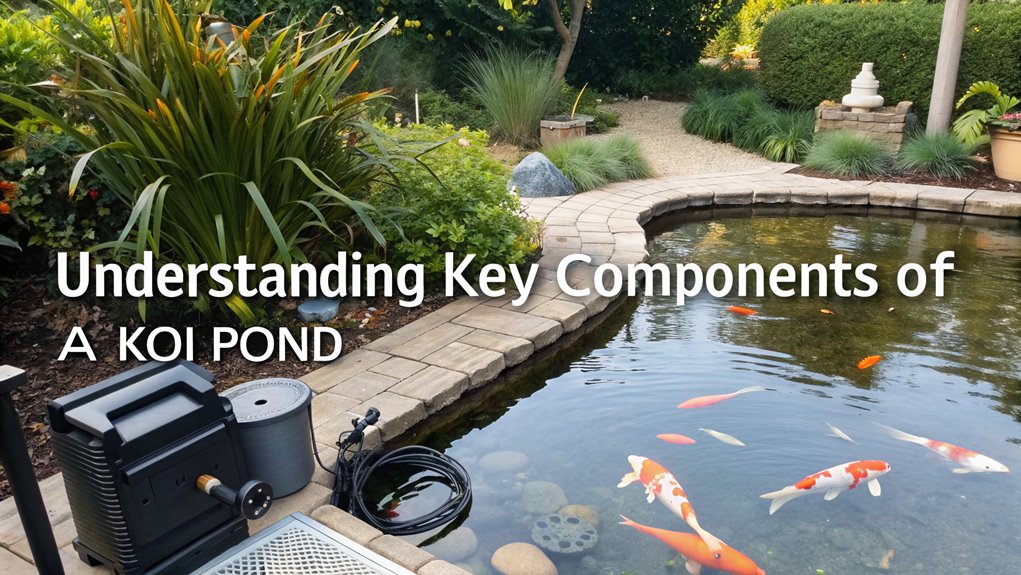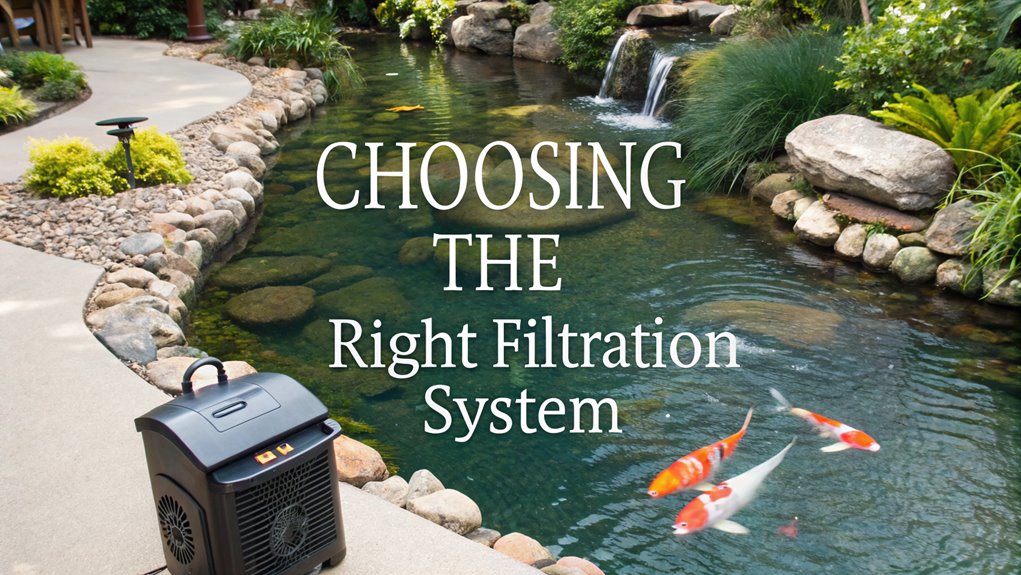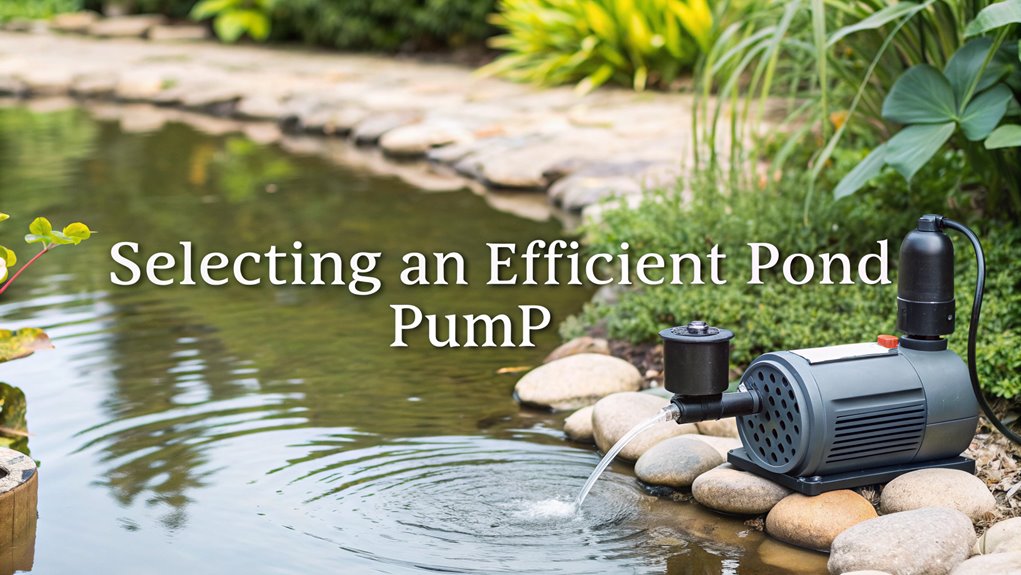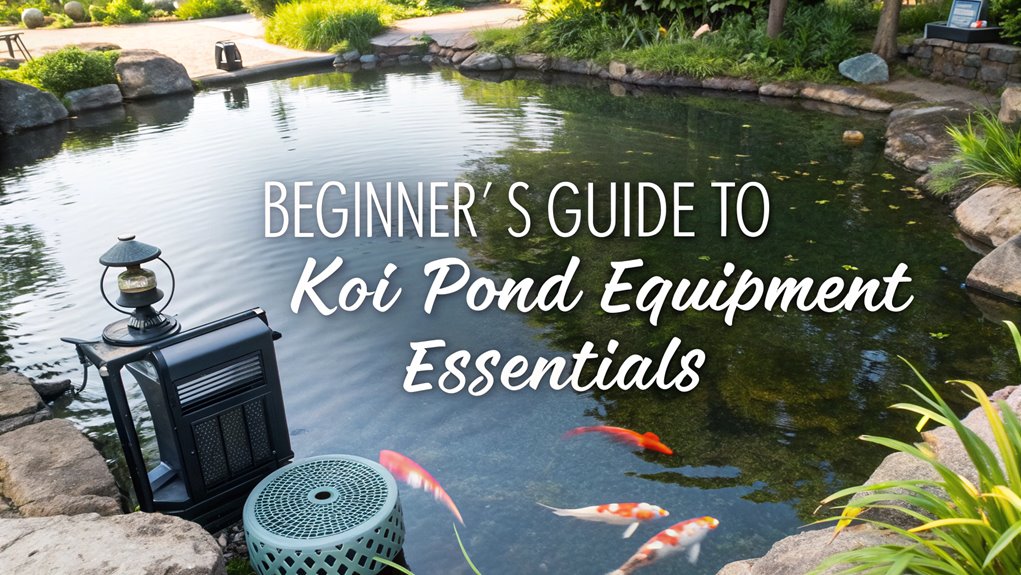In a koi pond, key equipment is crucial for maintaining ecosystem health. You need a reliable filtration system integrating mechanical and biological filters to trap debris and decompose waste. Pair it with a pond pump for effective circulation and oxygenation, ensuring water quality. Aeration equipment is vital for maintaining dissolved oxygen levels, supporting fish and bacteria. A durable EPDM pond liner prevents seepage, while a skimmer handles debris. Understanding these components will reveal more about creating a thriving koi pond.
Key Facts Summarized
- A reliable filtration system is crucial for trapping debris and promoting beneficial bacteria growth in a koi pond.
- Choose a pond pump that circulates the entire water volume at least once per hour for optimal pond health.
- Proper aeration equipment ensures adequate oxygen levels, supporting koi vitality and beneficial bacteria activity.
- Durable pond liners, like 45-mil EPDM, prevent water seepage and protect against contaminants effectively.
- Regular maintenance of skimmers keeps floating debris from overburdening the filtration system, maintaining a balanced ecosystem.
Understanding Key Components of a Koi Pond

When setting up a koi pond, it’s crucial to understand the key components that ensure a thriving aquatic environment.
A reliable filtration system is indispensable for maintaining water quality by trapping debris and utilizing beneficial bacteria.
The pond pump is vital for circulating water, oxygenating the pond, and preventing stagnation, promoting a healthy environment for your koi.
An efficient aeration system, such as air pumps or diffusers, supports dissolved oxygen levels, benefiting both fish and bacteria within the pond ecosystem.
UV clarifiers control algae, keeping the water crystal-clear while being safe for koi.
Lastly, a durable pond liner prevents water seepage, safeguarding against contaminants.
Regular maintenance of these components ensures a balanced and sustainable koi pond ecosystem, which is important for building a thriving ecosystem.
Choosing the Right Filtration System

To ensure your koi pond remains a vibrant and healthy aquatic environment, it’s essential to select the right filtration system.
A comprehensive filtration system integrates mechanical filters to capture debris, and biological filters that employ beneficial bacteria to decompose waste, thereby maintaining optimal water quality.
Pressure filters are particularly advantageous due to their dual functionality and ease of pond maintenance. They support koi health by ensuring efficient mechanical and biological filtration.
It’s vital to choose a system with a flow rate capable of circulating the entire pond volume hourly. Regularly cleaning the filter prevents waste accumulation, critical for sustaining a balanced ecosystem.
For ponds with larger koi populations, opt for a higher-capacity filtration system to manage increased waste effectively. Additionally, maintaining optimal water quality is crucial for preventing stress and health issues in your koi.
Selecting an Efficient Pond Pump

Having established the importance of a robust filtration system, selecting an efficient pond pump becomes equally vital for sustaining a healthy koi pond. The pond pump must circulate the entire volume of water at least once per hour to optimize water quality. Choose between submersible pumps for quiet operation and easy installation, or external pumps, ideal for larger ponds needing higher flow rates. Regular maintenance, such as cleaning filters, is essential to ensure peak performance and longevity of the pump.
| Pump Type | Benefits | Considerations |
|---|---|---|
| Submersible | Quieter, easy to install | Limited to smaller ponds |
| External | Higher performance, larger ponds | More complex installation |
| Energy-efficient | Reduced electricity costs | Check warranty details |
Ensure the flow rate aligns with your filtration system, aiming for 100-150 gallons per hour per 100 gallons of water. Evaluate the pump’s head height to ensure it adequately supports water features.
Importance of Aeration in Koi Ponds
Although often overlooked, aeration plays a critical role in maintaining the health and vitality of your koi pond.
Aeration equipment is vital for sustaining adequate oxygen levels, as koi require 6-8 mg/L of dissolved oxygen for optimal health. Proper aeration prevents pond stratification, ensuring even oxygen distribution and eliminating dead zones. This supports the proliferation of beneficial bacteria, crucial for breaking down harmful ammonia and nitrites, thereby enhancing water quality. Additionally, a balanced ecosystem is essential for reducing algae growth, which further contributes to overall pond health.
Essential Pond Liners and Skimmers for Maintenance
Building on the vital role of aeration, pond liners and skimmers also play pivotal roles in maintaining a robust koi pond ecosystem.
Pond liners, crafted from durable materials like EPDM with a minimum thickness of 45-mil, prevent water seepage and ensure long-lasting integrity. Secure installation, using heavy rocks and avoiding sharp objects, safeguards against punctures.
Meanwhile, skimmers are essential for optimal water quality, efficiently removing floating debris before it burdens the filtration system. Regular skimmer maintenance prevents debris buildup, maintaining a healthy environment for koi fish.
Selecting a skimmer that matches the pond’s surface area optimizes cleaning efficacy, promoting ecosystem balance. Together, these elements uphold a pristine habitat, facilitating the pond’s ecological equilibrium and enhancing your koi pond’s longevity. Additionally, proper maintenance requirements for your pond will ensure the health and well-being of your koi fish.
Regular Monitoring With Water Test Kits
To maintain a thriving koi pond, regular monitoring with water test kits is indispensable.
These kits are crucial for evaluating key parameters such as pH levels, ammonia, nitrite, nitrate, and kH. Keeping pH levels between 6.5 and 8.5 ensures a healthy environment and optimal koi health, as fluctuations can stress your fish.
Ammonia and nitrite should remain at 0 ppm, as even minimal concentrations can be toxic, disrupting the pond’s ecosystem. Conduct regular testing, ideally weekly, to detect imbalances early. This is particularly vital during warmer months when biological activity increases.
Consistent use of water test kits facilitates timely interventions, promoting stable water quality and a thriving ecosystem. By doing so, you’ll safeguard your koi’s well-being and longevity.
Frequently Asked Questions
What Equipment Do I Need for a Koi Pond?
You need a pond filter, pump, aeration system, UV clarifier, and water testing kits. These ensure optimal water quality by removing debris, circulating oxygen, controlling algae, and monitoring chemical levels, fostering a sustainable ecosystem for koi.
What Chemicals Do I Need to Start a Koi Pond?
Did you know that over 90% of koi health issues stem from poor water quality? To prevent this, use dechlorinators, pH stabilizers, ammonia detoxifiers, and beneficial bacteria. These chemicals ensure optimal conditions, minimizing stress and promoting koi vitality.
How to Start a Koi Pond for Beginners?
You’ll initiate a koi pond by selecting an optimal location, determining appropriate dimensions, and purchasing a comprehensive pond kit. Install a robust filtration system and routinely test water parameters like pH and ammonia for healthy koi growth.
What Is the Beginner Guide for Koi Fish?
You’ll start by selecting resilient varieties like Kohaku and Sanke. Ensure gradual acclimation over 1-2 hours. Maintain a temperature of 65°F-75°F, one koi per 100 gallons, and monitor pH, ammonia, and nitrate levels regularly.
Conclusion
You’ve navigated the labyrinth of koi pond equipment, wielding filtration and aeration like a seasoned aquarist. Imagine your pond as a finely tuned orchestra, where pumps and liners play their parts with precision, and skimmers dance gracefully across the water’s surface. Don’t forget to wield your water test kit like a scientist in a lab coat, ensuring the perfect aquatic symphony. So, dive in with your newfound expertise and transform your backyard into a gilled utopia.
